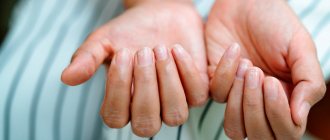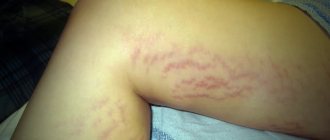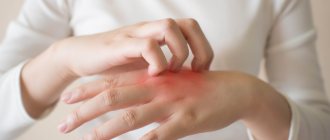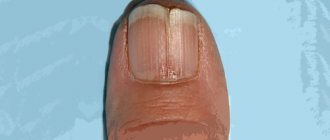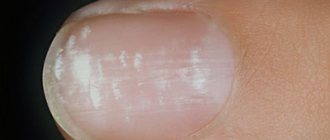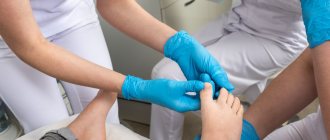Nails are not only a decoration for a person's hands, but, above all, they have a protective function for the fingertips and they also facilitate precise handling. Unfortunately, nails are often affected by numerous diseases.
Nail diseases - types
Many nail diseases are the result of poor nutrition, low in vitamins and minerals. Split nails usually indicate a lack of calcium and zinc.
Their excessive fragility is due to a lack of vitamins of the silicon, magnesium, iron and B group. White spots on the nails should lead to replenishment of calcium deficiency, and longitudinal grooves – deficiency of iron, as well as vitamins A and D.
The nail plate is also weakened by contact with detergents and certain diseases, including diabetes and thyroid disease.
Why does a cavity form under the fingernail:
- nail injury;
- chemical burns resulting from the use of low-quality gel polishes or from contact with household chemicals and other aggressive substances;
- thinning of nails as a result of self-removal of artificial coating or sawing of the nail plate with a file (cutter) by a master;
- onychophagia, or a mental disorder in which a person bites or picks at the nail beds and the skin around them. As a result, the nail peels off from the nail bed;
- attempts to move the hyponychium or clean out dirt under the nails with something sharp;
- dermatological pathologies.
If you notice the first symptoms of onycholysis, contact the PODOLAB Podology Center in St. Petersburg. Podologists will advise you on this problem. And you will quickly restore the attractive appearance of your nails.
Nail diseases - symptoms
Symptoms of nail disease are visible to the naked eye. Therefore, they should pay special attention to:
- nail color - white, yellow, green, gray, brown can be a symptom of the disease;
- the shape of the nails - scapular, gonadal, tubular - is incompatible with the natural growth of the nail;
- nail structure - longitudinal grooves and transverse grooves should attract attention;
- general condition of nails – brittle, peeling;
- condition of the skin around the nails - redness, swelling, bumps.
Symptoms of onychocryptosis
With onychocryptosis, the lateral part of the nail abuts the periungual fold and continues to grow inside it. At first, the patient feels general discomfort, redness of the skin around the nail is observed. It is also possible to change the shape of the nail. Preferences in shoes are gradually changing, the choice is given to open options, wearing tight, narrow, and over time, any closed shoes becomes difficult. In case of inaction, the symptoms of the disease become more pronounced, complications appear, and over time, surgical intervention becomes inevitable.
The main symptoms of an ingrown toenail include:
Painful sensations in the toe area resulting from injury, after wearing shoes, or for no apparent reason
· swelling and hyperemia (overflow of blood vessels of the circulatory system of any area of the body) of the periungual fold
formation of pus in the area of the nail plate
formation of excess connective tissue protruding from the wound, visually reminiscent of raw meat
In medicine, the development of onychocryptosis is characterized by three main stages - mild, moderate and severe.
Stages of onychocryptosis
First (mild) stage
characterized by redness of the periungual fold and moderate swelling. At this stage, the nail plate has no visual changes, and painful symptoms usually appear while walking in shoes.
Second (moderate) stage
accompanied by signs of inflammatory processes: the periungual fold becomes red, purulent discharge appears, and in some cases painful pulsation is observed. The nail becomes denser and dull.
Third (severe) stage
caused by hyperemia (increased blood supply) of the periungual ridges, the formation of hypergranulation (tissue growth in areas of inflammation), an increase in the volume of the phalanx, and the presence of purulent discharge. The nail becomes brittle and mobile, the skin around it visually resembles raw meat (this symptom is called “wild meat” in medicine).
Complications of onychocryptosis
Prolongation of the disease leads to the development of infections, which certainly aggravates the situation. Wounds that are open for a long time and do not heal are an excellent breeding ground for bacteria. An infected wound heals slowly as the body tries to heal the affected area, resulting in bright red granulation tissue forming at the site of the ingrown nail. If you do not start treatment or start the wrong treatment, the granulation becomes dense, the phalanx changes shape, and it becomes impossible to solve the problem with conservative methods. In addition, inflammation of the soft tissues of not only the fingers, but also the entire foot is likely to develop, which, if left untreated, can spread to the bones and lead to osteomyelitis.
Complications of onychocryptosis are associated mainly with the development of infectious and inflammatory processes and include:
· abscess
(limited inflammatory purulent focus causing intoxication) fingers. It is characterized by the presence of pronounced swelling and redness of the skin. Surgery required.
· lymphangitis
(acute or chronic inflammation of the lymphatic trunks and capillaries, occurring secondarily against the background of purulent-inflammatory processes). It is characterized by the spread of infection throughout the lymphatic system, affecting blood vessels. Complex treatment is required, including anti-inflammatory and antibacterial therapy.
· gangrene
(death of living tissue) of the finger. Characterized by processes leading to irreversible necrosis of soft tissues. Amputation of the affected phalanx or the entire finger is required.
· osteomyelitis
(purulent - inflammatory process that develops in the bones, bone marrow and surrounding soft tissues) of the finger. The infection affects the bones. Drug therapy is required. Amputation of the phalanx of the finger is possible if the patient comes too late.
The risk of complications increases in the presence of concomitant diseases associated with disruption of blood vessels, for example, diabetes mellitus and atherosclerosis. The risk group also includes people who are overweight and over the age of 60.
Nail diseases - treatment
If you notice any symptoms, you should consult a dermatologist. It is necessary to find the cause of the change and exclude serious diseases, such as: thyroid disease, syphilis, anemia, lack of micro and macro elements. Treatment depends on the type and severity of the disease. Some of them are treated with topical medications. In more severe cases, surgery may be required. Therapy is selected individually, taking into account the needs of the patient.
Unfortunately, nail diseases are quite common. Most often, they affect women who use cosmetic procedures in salons where hygienic conditions are not properly maintained.
Care for minor injuries
The patient can often self-treat nail damage at home:
- remove gel polish from damaged nail;
- Gently wash the affected area with fragrance-free soap;
- dressing the wound if there is an open injury;
- immediately after injury - applying cold (ice) for about 20 minutes at a time;
- raise the injured leg above body level;
- application of gentle compression (until hematoma forms);
- taking over-the-counter pain medications as directed.
The most common nail diseases
Nail candidiasis is a fungal disease of the nails that causes severe blackening, perigungual swelling and pain. Treatment is based on antifungal drugs.
Nail psoriasis occurs in combination with skin psoriasis and is an important part of the diagnosis of this disease. The nails become thickened, brittle, and have numerous transverse grooves and pinpoint cavities. In advanced forms of the disease, extensive onycholysis may develop.
Leukonychia is the so-called nail vitiligo, which appears as white spots. It is not a disease in itself, but can be a symptom of infection, ringworm, zinc and protein deficiencies, and kidney or heart failure.
Onycholysis is the separation of the stratum corneum from the finger. It appears gradually, starting from the edge of the nail. The nail becomes distorted and changes color to white, yellowish and even greenish. The causes of this disease can be mechanical damage, improperly performed care procedures, bacterial and fungal infections, harmful effects of chemicals, psoriasis or thyroid hormone disorders.
You can protect yourself from these diseases by following hygiene rules and choosing sterile beauty salons equipped with professional disinfection equipment.
Diagnosis of the disease
First of all, a visual examination and history taking are necessary. It is important to identify the presence of concomitant diseases - to exclude or confirm fungal infections and diseases that are associated with disruption of blood vessels (diabetes mellitus, atherosclerosis).
Diagnosis of onychocryptosis includes
:
· collecting anamnesis (full collection of data about the patient and his diseases): identifying the causes of the disease, collecting complaints
· visual examination of the patient (diagnosing the stage of the disease and identifying complications): the condition of the nails, periungual ridges, skin of the fingers and feet; the presence of deformation of the fingers, swelling, purulent inflammation, granulation; comparison of two limbs
· general blood test (if complications are detected): carried out to identify or exclude a general inflammatory process. A blood glucose test is also performed to confirm or rule out diabetes.
· bacteriological examination of discharge from wounds (analysis of purulent discharge): the study is carried out to determine the type of pathogen and the severity of the inflammatory process
· X-ray examination (study of the internal structure of the foot): carried out to study the anatomical changes in the structure of the foot and to identify or exclude the transition of inflammatory processes to the bones
The most common toenail diseases
Onychomycosis is one of the most common toenail diseases, but it can also appear on the toenails. Fungi, or rather dermatophytes, thrive in the nail environment.
The infection usually occurs when using swimming pools or public showers. Mycosis manifests itself as a color change to yellow, brown or white. There is also deformation of the nail plate and onychlinosis. Treatment requires the administration of appropriate antifungal drugs. If treatment is unsuccessful, surgical removal of the nail may also be necessary.
In prevention, foot hygiene, thorough drying after each wash and cutting nails short are important. You cannot lend shoes, a towel or nail scissors to anyone.
An ingrown toenail is most often found on the largest toenail and is the result of improper care or shoes that are too tight. The cause may also be a nail disease, such as mycosis. Depending on the cause, a treatment method is established.
Reasons for the development of onychodystrophy
A longitudinal crack in a toenail can ruin the neatness of the entire pedicure. Unfortunately, very often it is not enough to just restore the beauty of the nail plate, because if you do not influence the cause of onychodystrophy, then there is a possibility that the process will worsen.
In order to completely get rid of this defect of the nail plate, the intervention of related specialists is often required.
The main causes of onychodystrophy:
Caused by endogenous (internal) factors:
- Lack of vitamins, minerals, micro- and macroelements;
- Congenital anomalies;
- Skin diseases (psoriasis, dermatitis, lichen planus, neurodermatitis, etc.);
- Endocrine pathologies (diabetes mellitus, hypothyroidism, hyperthyroidism, etc.);
- Malignant and benign neoplasms;
- Diseases of the heart and blood vessels;
- Reduced immune reactivity of the body;
- Pathologies of the gastrointestinal tract (ulcers, gastritis, etc.);
- Frequent stress;
- Lack of proper rest;
- Abnormalities in the blood picture (for example, iron deficiency anemia).
Caused by exogenous (external) factors:
- Fungal nail diseases;
- Bacterial lesions of the nail plate;
- Nail injuries;
- Improper care of nail plates;
- Rough, improper removal of gel polish;
- Using aggressive household chemicals in everyday life;
- Unbalanced diet;
- Low quality of drinking water;
- Adverse environmental impact;
- Exposure to ultraviolet radiation.
More often the phenomena of onychodystrophy are observed in women. This pathology in the fair sex manifests itself in increased fragility and lamination of the nail plate. Perhaps this is due to the not always high-quality service in beauty salons.
Men more often turn to specialists with fungal or bacterial nail infections.
In childhood, onychodystrophy most often appears due to trauma to the nail plate.
In order to establish the cause of onychodystrophy, you need to consult a podiatrist. The specialist will be able to diagnose the pathology, draw up a competent treatment plan, and also prescribe the necessary consultations with doctors of other profiles.
Symptoms of onychodystrophy
Depending on the cause of onychodystrophy, the disease can have different manifestations.
Congenital onychodystrophies:
- Onychomadesis is the separation of the nail from the skin at the points of its attachment to the skin folds.
- Koilonychia is a nail shape disorder in which the nail plate takes the shape of a saucer.
- Anochylia is the congenital absence of one or more nail plates.
- Platonychia is flattening and thickening of the nail plate.
- Micronychia is a pathology characterized by shortening of the nails.
- Hippocratic nails are a congenital enlargement of the nails, as well as an irregular shape of the nail plates.
Acquired onychodystrophies:
- Onychoschisis is a transverse division of the nail into several components.
- Onychorrhexis is the appearance of a crack along the nail without manifestation of an inflammatory reaction.
- Manicure onychodystrophy is the appearance of depressions on the nail from one edge to the other.
- Median canaliform onychodystrophy is the appearance of one median crack on the nail plate, from which smaller cracks extend.
- Onycholysis is the slow detachment of the nail from the nail bed with its complete preservation.
- Onychogryphosis is age-related changes in the nail, characterized by thickening and curvature.
- Leukonychia is a change in the color of the nails in the form of long white stripes.
- Hyperpigmentation is a change in the color of nails when taking medications, the appearance of subungual dystrophy or somatic pathologies.
- Scleronychia – increased hardness of the nail plates. Often found in endocrine diseases.
- Hapalonychia – extreme softness and pliability of the nail. Most often present in pathologies of the endocrine system.
- Trachyonychia - turbidity, roughness, separation of the nail plate. In most cases, it is a manifestation of immunodeficiency.
- “Thimblestone” onychodystrophy is the appearance of depressions on the surface of the nail. Most often it indicates the appearance of psoriasis.
Symptoms of onychodystrophy are varied. Therefore, in order to establish the true cause of the pathology, as well as find an effective method of treatment, you need to consult a podiatrist.
If you do not contact a specialist in a timely manner, as well as in the complete absence of treatment, the following complications may occur:
- Nail destruction (complete/partial);
- Attachment of a bacterial or fungal infection;
- Inflammation of the periungual fold;
- Progression of somatic pathology.
To avoid the development of complications, it is important to consult a specialist in a timely manner. Mikulo Natalya Valerievna is a podiatrist with extensive clinical experience. The specialist conducts an appointment at the address: Moscow, Konkovo st. Profsoyuznaya, building 109, shopping center “Seventy-seventh”.
Why do adults and children develop cracks?
As a rule, onychorrhexis is not an independent disease. Most often, this is only a symptom of somatic pathology. Therefore, when longitudinal separation of the nail appears, qualified assistance is required not only from a podiatrist, but also from a therapist, endocrinologist, cardiologist or other specialists.
Each age may have its own reasons for the appearance of onychorrhexis. For example, in childhood, such a pathology can arise against the background of an irrational, unbalanced diet. The child’s body needs a large amount of vitamins, minerals, macro- and microelements - this is the key to the harmonious growth and timely development of the baby. If, for some reason, these “building materials” are not enough, then health problems of varying degrees and varying severity appear.
At a more mature age, onychorrhexis may appear for the following reasons:
Somatic diseases:
- Autoimmune diseases;
- Skin and venereological pathologies;
- Diseases of the gastrointestinal tract;
- Pathologies of the endocrine system;
- Vascular diseases;
- Mental disorders.
Other factors:
- Nail plate injuries;
- Frequent use of caustic household chemicals;
- Carrying out a manicure without understanding the structure of the nail plate;
- Viral and bacterial infections;
- Improper removal of gel polish;
- Unbalanced diet;
- Low quality of drinking water;
- Bad ecology.
Thus, when treating a cracked toenail, it is not enough to restore the aesthetics of the nail plate; it is equally important to identify and eliminate the factor that contributes to the formation of onychorrhexis.
Where to find a podologist in Moscow with extensive clinical experience? Mikulo Natalya Valerievna is a podiatrist with extensive experience. The specialist is accepted at the medical office, which is located at Moscow, Konkovo st. Profsoyuznaya, building 109, shopping center “Seventy-seventh”.
Treatment of cracked nail plates along and across
Treatment for a cracked toenail almost always requires an integrated approach to the problem. Unfortunately, correcting a defect only cosmetically is not always the right solution in this case. After all, external beauty can provoke the development of complications on the nail plate. Therefore, it is extremely important to find the cause of the cracked toenail and also eliminate it.
So, for example, if onychodystrophy is caused by somatic pathology, then to eliminate it requires consultation with related specialists - an endocrinologist, cardiologist, therapist, or others.
The elimination of deformations of the nail plates is carried out by a podiatrist. After collecting an anamnesis, examining the affected area and making a diagnosis, the doctor will make a diagnosis and also outline a rough treatment plan. In each specific case, the therapy program is compiled individually.
An approximate diagnosis plan for onychodystrophy includes the following points:
- Dermatoscopy;
- Sowing for fungal flora;
- Microscopy of scraping.
Main activities included in the treatment plan:
- Prescription of drugs. Most often this includes vitamin-mineral complexes, immunostimulants, and drugs that improve peripheral circulation. Sedatives are prescribed slightly less frequently.
- Physiotherapeutic treatment. This group of therapeutic effects can include hot baths with sea salt or essential oils. Paraffin therapy has a good effect.
- Massage.
- Treatment of nail plates using devices and local preparations.
- Use of keratolytic patches as prescribed by a doctor.
- Compliance with water regime, as well as a balanced diet.
- Consultation with doctors of other specialties (if necessary).
Nail disease in children
Nail diseases in children are most often caused by infections. This leads not only to destruction of the nail plate, but also to the appearance of open wounds.
Warts are caused by HPV that enters the body through mechanical damage. Symptoms include red or grayish nodules. Most often they appear next to the nail, but it happens that the wart can be located under the nail plate. This causes pain and discomfort. Their treatment is very burdensome. Chemicals, laser therapy and eventually surgical methods are used.
Mycosis of the nails in children is also common. This is due to reduced immunity and frequent trips to the pool or sports club. It is necessary to ensure that the child only uses his own towel and always remembers hygiene. Treatment is long and burdensome, so prevention is better than cure.
Section: Articles Tags: dermatology

